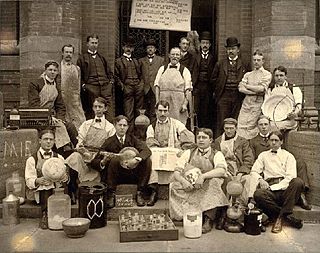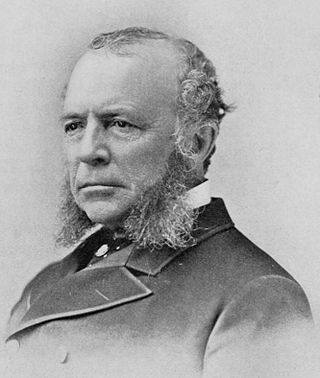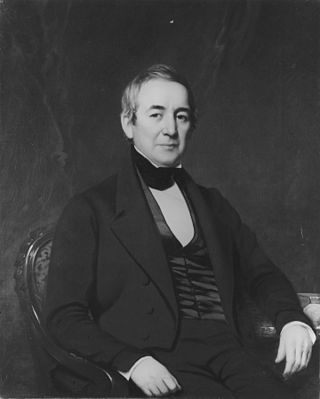
Ezra Stiles was an American educator, academic, Congregationalist minister, theologian, and author. He is noted as the seventh president of Yale College (1778–1795) and one of the founders of Brown University. According to religious historian Timothy L. Hall, Stiles' tenure at Yale distinguishes him as "one of the first great American college presidents."

William Whiting Boardman was a politician and United States Representative from Connecticut.

Sheffield Scientific School was founded in 1847 as a school of Yale College in New Haven, Connecticut, for instruction in science and engineering. Originally named the Yale Scientific School, it was renamed in 1861 in honor of Joseph E. Sheffield, a railroad executive. The school was incorporated in 1871. The Sheffield Scientific School helped establish the model for the transition of U.S. higher education from a classical model to one which incorporated both the sciences and the liberal arts. Following World War I, however, its curriculum gradually became completely integrated with Yale College. "The Sheff" ceased to function as a separate entity in 1956.

Edward John Phelps was a lawyer and diplomat from Vermont. He is notable for his service as Envoy to Court of St. James's from 1885 to 1889. In addition, Phelps was a founder of the American Bar Association, and served as its president from 1880 to 1881.

Edward Alexander Bouchet was an American physicist and educator and was the first African American to earn a Ph.D. from any American university, completing his dissertation in physics at Yale University in 1876. On the basis of his academic record he was elected to the Phi Beta Kappa Society. In 1874, he became one of the first African Americans to graduate from Yale College.

The Vermont National Guard is composed of the Vermont Army National Guard and the Vermont Air National Guard. Together, they are collectively known as the Green Mountain Boys. Both units use the original Revolutionary War-era Flag of the Green Mountain Boys as their banner. In 2009, they had 2,600 members.
Ralph Isaacs Ingersoll was a lawyer, politician, and diplomat who served as a member of the Connecticut House of Representatives, where he was Speaker of the House, a United States representative from Connecticut for four consecutive terms from 1825 to 1833, and was the U.S. Minister to the Russian Empire under President James K. Polk in the late 1840s.

Asa Peabody Blunt was an officer in the Union Army during the American Civil War. He remained on active duty after the war. In recognition of his service during the Civil War, he was appointed to the grade of brevet brigadier general of volunteers. Blunt was notable as commander of the 2nd Vermont Brigade and the United States Disciplinary Barracks at Fort Leavenworth, Kansas.
Colin Macrae Ingersoll was a Connecticut attorney, politician, and military leader. He served as a member of the United States House of Representatives for two terms in the 1850s.

Henry Champion Deming was a politician and writer who served as U.S. Representative from Connecticut, the mayor Hartford, the acting military mayor of New Orleans, and a member of the Connecticut House of Representatives, and collector of Internal Revenue

Charles Anthony Ingersoll was a United States district judge of the United States District Court for the District of Connecticut and member of the prominent Ingersoll political family of Connecticut.

William Thompson Lusk was an American obstetrician and a soldier who rose to the rank of Assistant Adjutant-General in the United States Volunteers during the first three years of the American Civil War. After he retired from the Union Army, he finished his medical education and became a professor as well as a president of the Bellevue Hospital Medical College. He received much recognition and fame for his 1882 book, The Science and Art of Midwifery, which quickly became a widely referenced text.

Edgar Gibson "Eddie" Crossman. was an attorney and senior partner in Davis, Polk, Wardwell, Sunderland & Kiendl, an officer in the United States Army in World War I and World War II, and a diplomat.

John Denison Champlin Jr. was a nonfiction writer and editor from the United States. As an editor, he worked in journalism and graphic arts.
John Keyes, son of Sampson Keyes, was the first Adjutant General of the State of Connecticut, being appointed to that position in 1782 and retiring from service in 1791. He also served in the American Revolution in the Continental Army.
Samuel L. Pitkin, born in Hartford, Connecticut on April 1, 1803, was the Adjutant General for the State of Connecticut from 1837 to 1839. He was a member of the Pitkin family of Hartford, who were very active in politics, the military, industry and banking in early Connecticut. His great-great-great grandfather, William Pitkin, emigrated to the new world from England in 1635 after receiving an inheritance. His grandson, also named William Pitkin would serve as governor of Connecticut Colony from 1766 to 1769.

Edward Swift Isham was an American lawyer and politician from Vermont. The son of a justice of the Vermont Supreme Court, Isham attended Williams College and the Harvard School of Law before he was admitted to the bar in 1858. He headed west, establishing a practice in Chicago, Illinois, in 1859. The practice eventually became Isham Lincoln & Beale. Isham also served one term in the Illinois House of Representatives.

William Petit Trowbridge was a mechanical engineer, military officer, and naturalist. He was one of the first mechanical engineers on the faculties of the University of Michigan, the Sheffield Scientific School of Yale, and the Columbia School of Mines. He had a brief military career after graduating from West Point and later served as Adjutant General for the State of Connecticut from 1873 to 1876. During his career as a surveyor on the American Pacific coast he collected thousands of animal specimens, several of which now bear his name.

Seth Perkins Staples was an American lawyer and politician. He founded what became the New Haven Law School, which was absorbed by Yale University as their Yale Law School. He was the brother-in-law of Roger Sherman Jr.
Eliakim Doolittle was an American composer, schoolteacher, and singing teacher, the younger brother of Amos Doolittle, first cousin of composers Reuben Munson and Amos Munson, and uncle of senator James R. Doolittle. His most well-known composition was the hymn tune "Exhortation", a fuging tune that was first printed in The Musical Harmonist and later included in The Sacred Harp.















